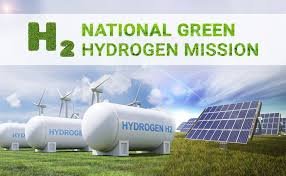Introduction
India is rapidly emerging as a global leader in green hydrogen, a crucial element in achieving a sustainable energy future. With ambitious policies, investments, and technological advancements, the country is positioning itself at the forefront of the green hydrogen revolution. The Indian government has set a roadmap to enhance production capacity, reduce dependence on fossil fuels, and establish itself as an exporter of green hydrogen in the coming years.
India’s Commitment to Green Hydrogen
Recognizing the role of green hydrogen in achieving net-zero emissions, the Government of India launched the National Green Hydrogen Mission (NGHM) in 2023. This initiative aims to make India a global hub for green hydrogen production, ensuring energy security and economic growth. The mission outlines a production target of 5 million metric tonnes per annum (MTPA) by 2030 and includes investments exceeding ₹19,000 crore.
Key Developments in Green Hydrogen Sector
Several crucial developments have marked India’s journey in green hydrogen:
- Policy Initiatives: The government has introduced subsidies, tax benefits, and incentives for industries investing in green hydrogen production.
- Public-Private Partnerships: Major corporations like Reliance Industries, Adani Group, and Indian Oil Corporation have announced large-scale investments in green hydrogen projects.
- International Collaborations: India has signed agreements with countries such as Japan, Germany, and the UAE to boost research, technology exchange, and export opportunities.
- Infrastructure Expansion: The development of hydrogen production plants, refueling stations, and dedicated corridors for transportation is underway.
- Research and Innovation: Indian research institutions and startups are working on cost-effective electrolysis and storage solutions to make green hydrogen commercially viable.
Challenges and the Road Ahead
Despite the promising progress, India faces several challenges in scaling up green hydrogen production:
- High Production Costs: The cost of electrolyzers and renewable energy integration remains a key hurdle.
- Lack of Infrastructure: Hydrogen storage, transportation, and distribution infrastructure are still in their nascent stages.
- Policy and Regulatory Frameworks: The need for clear regulatory guidelines and safety standards is crucial for long-term adoption.
To overcome these challenges, the government is focusing on research incentives, infrastructure development, and collaborations with international players.

Why This News Is Important
Significance for India’s Energy Security
India’s leadership in green hydrogen is a major step toward reducing dependency on fossil fuels and achieving energy self-sufficiency. With increasing energy demands and volatile global oil prices, green hydrogen can play a pivotal role in ensuring stable energy supplies.
Economic and Employment Opportunities
The green hydrogen sector is expected to generate millions of jobs in production, research, and infrastructure development. It presents opportunities for skill development, innovation, and new business ventures, benefiting India’s economy.
Global Climate Goals and India’s Contribution
India’s commitment to green hydrogen aligns with its target of achieving net-zero carbon emissions by 2070. This initiative will contribute significantly to global climate action and sustainable development goals (SDGs).
Historical Context
Evolution of Hydrogen as an Energy Source
Hydrogen has been used as an industrial gas for decades, primarily in refining and chemical industries. However, with advancements in electrolysis and renewable energy, green hydrogen has emerged as a viable alternative to fossil fuels.
India’s Renewable Energy Journey
India has been a pioneer in adopting renewable energy sources such as solar and wind power. With over 170 GW of renewable energy capacity, the country is leveraging its existing infrastructure to drive green hydrogen production.
Global Hydrogen Initiatives
Countries like Germany, Japan, and the USA have been investing heavily in green hydrogen. India’s entry into this space is timely and aligns with the global push for decarbonization and clean energy transitions.
Key Takeaways from “India’s Leadership in Green Hydrogen”
| Serial No. | Key Takeaway |
|---|---|
| 1 | India has launched the National Green Hydrogen Mission to boost production and adoption. |
| 2 | The country aims to produce 5 MTPA of green hydrogen by 2030. |
| 3 | Government policies, public-private partnerships, and international collaborations are driving growth. |
| 4 | Major challenges include high production costs, lack of infrastructure, and regulatory gaps. |
| 5 | Green hydrogen will play a crucial role in India’s energy security, economic growth, and climate goals. |
FAQs: Frequently Asked Questions
1. What is the National Green Hydrogen Mission?
The National Green Hydrogen Mission is an initiative launched by the Government of India to promote the production, adoption, and export of green hydrogen, with a target of 5 MTPA by 2030.
2. Why is green hydrogen important for India?
Green hydrogen is crucial for reducing dependency on fossil fuels, achieving energy security, and contributing to India’s net-zero emissions target by 2070.
3. What are the major challenges in green hydrogen adoption?
The key challenges include high production costs, lack of infrastructure, and the need for a clear regulatory framework.
4. Which industries will benefit the most from green hydrogen?
Industries such as transportation, power generation, steel production, and chemicals will significantly benefit from green hydrogen adoption.
5. How does India compare with other countries in green hydrogen development?
India is among the leading nations investing in green hydrogen, alongside Germany, Japan, and the USA, with a focus on becoming a global hub for production and exports.
Some Important Current Affairs Links


















 Exciting News!
Exciting News!  Join Our Telegram Channel Now!
Join Our Telegram Channel Now!
 Join our Telegram channel for a thrilling adventure into the world of daily current affairs.
Join our Telegram channel for a thrilling adventure into the world of daily current affairs. 
 Don’t miss out on the latest updates and insights! Click to join now and be part of the knowledge revolution!
Don’t miss out on the latest updates and insights! Click to join now and be part of the knowledge revolution! 
